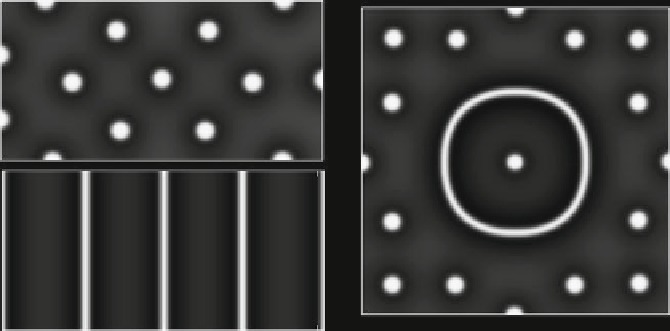Environmental Engineering Reference
In-Depth Information
1
2
1
0
2
0
1
2
x
x
Fig. 7.4 Formation of Turing patterns for different perturbations of the spatially uniform distri-
bution of (
7.10
and
7.11
). Parameters:
r
¼
5/14,
K
¼
7/50,
a
¼
2/3,
b
¼
5/3,
e
¼
3/5,
m
¼
7/40,
g
2
2/125,
h
2
10
3
,
D
2
10
3
(a.u.), no-flux boundary conditions
¼
¼
1/25,
Y
3
¼
1,
D
1
¼
¼
2
These stationary spots and stripes are typical representatives of Turing struc-
tures. There have been many discussions about the role of diffusive instabilities in
forming population or animal coat patterns. Natural patterns never have this
symmetric shape; however, the pattern can be altered by noise.
7.4.2 Target Patterns and Spiral Waves
In addition to stationary Turing patterns, (
7.10
and
7.11
) also allow for dynamic
spatiotemporal patterns. Therefore, assume that our sample system (
7.10
and
7.11
)is
in the parameter region of limit cycle oscillations. In this case, any local perturbation
leads to the formation of concentric waves, the so-called target patterns. A subsequent
perturbation of the circular wave fronts, like a collision with an obstacle, the domain
boundary or another wave, may cause the opening of these fronts and spiral waves to
appear. The two corresponding patterns are shown in Fig.
7.5
.
Closely related to this phenomenon are periodic and irregular travelling waves
(see Sherratt and Smith 2008 for a review of theoretical results and field studies)
and the so-called 'wave of chaos' (Malchow et al. 2008), which can be seen as the
spatially one-dimensional analogon to the target pattern shown in Fig.
7.5
.
The effects described above are examples of irregular spatiotemporal dynamics.
There are numerous other examples of temporally and spatiotemporally irregular
oscillations in model systems and there is an ongoing discussion about the role and
identification of deterministic chaos in ecology. It has been identified in laboratory
systems (Becks et al. 2005; Cushing et al. 2003), but it will always be hard to
distinguish between deterministic and stochastic effects in real data.

